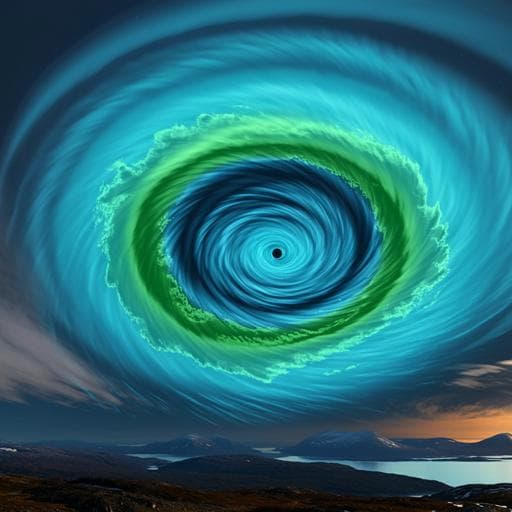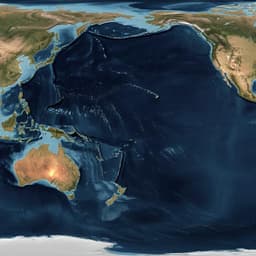
Earth Sciences
Slow-down in summer warming over Greenland in the past decade linked to central Pacific El Niño
S. Matsumura, K. Yamazaki, et al.
Discover groundbreaking insights as Shinji Matsumura, Koji Yamazaki, and Kazuyoshi Suzuki reveal how intensified cyclonic circulation and Central Pacific El Niño events have influenced the recent slowdown in Greenland's warming and Arctic sea-ice loss. This study uncovers the atmospheric connections that challenge the prevailing narratives of climate change in the Arctic.
~3 min • Beginner • English
Introduction
The study addresses why Greenland's summer warming and ice loss have slowed since the early 2010s, despite continued Arctic warming elsewhere. Prior to 2012, Greenland warming was amplified by an intensified anticyclone linked to tropical Pacific teleconnections and a negative NAO, enhancing melt via reduced cloud cover and lower surface albedo. However, subsequent cooling/slowdown over Greenland contrasts with Arctic-wide trends and appears tied to natural variability that most climate models struggle to capture. Summer teleconnections from the tropics are generally weaker due to seasonal circulation characteristics (weaker subtropical jet, displaced westerly ducts, equatorial easterlies), making the propagation pathway unclear. The study's purpose is to identify the mechanism behind the recent slowdown of Greenland summer warming by focusing on summertime teleconnections from the tropics, hypothesizing a key role for central Pacific (CP) ENSO.
Literature Review
Background work links Greenland warming to teleconnections from the tropical Pacific and phases of the NAO, with anticyclonic conditions over Greenland enhancing melt via cloud and albedo changes. Many models fail to simulate unforced natural variability and summer Greenland blocking. Most prior studies emphasized winter teleconnections, when ENSO peaks and extratropical influences are strongest. Recent studies indicate that summer tropical SSTs can affect Arctic sea ice through teleconnections, though models often fail to replicate these. Summer circulation features (weak/northward jets, westerly ducts displaced, equatorial easterlies) inhibit tropical-extratropical propagation, leaving the summer mechanism unresolved. Evidence also points to decadal changes in ENSO type, with more frequent CP El Niño events in recent decades potentially altering teleconnection patterns.
Methodology
Observational and reanalysis data: Atmospheric fields from JRA-55; SST and sea-ice concentration from HadISST; September Arctic sea ice extent from NSIDC; precipitation from GPCP; Greenland surface air temperature from DMI synoptic stations; additional SAT trends from GHCN CAMS and ERA5. Greenland Blocking Index (GBI) defined as area-weighted mean 500-hPa height over 60°–80°N, 20°–80°W. CP ENSO measured by El Niño Modoki Index (EMI), defined as the difference between central Pacific SST anomalies and averaged anomalies over western and eastern Pacific boxes.
Analyses: Focus on June–August (JJA). Empirical orthogonal function (EOF) analysis of the eddy component (zonal mean removed) of 250-hPa geopotential height over 0°–90°N, 140°E–20°W (1979–2020), with cosine-latitude weighting. Running correlations and linear detrending applied; significance via two-tailed t-tests. Regressions of circulation, SAT/SST, precipitation, sea ice concentration, and winds onto PCs and EMI. EMI-related components removed via linear regression where noted.
Modeling: AMIP-type ensembles from FACTS using ECHAM5 (50-member mean, 1979–2019) under (1) observed radiative forcing and SST, and (2) 1880s radiative forcing with detrended SST adjusted to 1880 mean.
Linear baroclinic model (LBM): T42 spectral resolution with 20 vertical levels; idealized diabatic heating (1 K day−1) peaked at 500 hPa, horizontal half-widths 20° longitude and 6° latitude. Basic state from monthly NCEP–NCAR climatology (1979–2010). Experiments: (1) single heating at specified grid points (e.g., 5°N/120°W or 15°N/120°W), (2) systematic longitude/latitude grid of heating centers (20° lon × 5° lat resolution from equator to 30°N), and (3) repeating (2) for each month. Responses analyzed at day 30.
Key Findings
- Greenland JJA temperature at 700 hPa peaked in 2012 and then slowed/declined despite ongoing GHG forcing; surface observations along the west coast and Summit corroborate the cooling/slowdown. Arctic September sea ice extent reached a record low in 2012, with no new record minima thereafter and a decelerated loss rate.
- ECHAM5 ensemble with observed forcing reproduces the warming trend from the early 1990s but not the recent slowdown; a parallel ensemble with 1880s forcing also shows a comparable warming trend, indicating natural variability accounts for roughly half of the 1979–2019 Greenland warming (temperature change 0.84 °C under observed forcing vs 0.38 °C under 1880s forcing).
- GBI peaked in 2012 then decreased with large interannual variability; correlations between GBI and Greenland SAT remained strong post-2000. GBI correlations with SAT and September SIE show nonstationary behavior, strengthening after 2000.
- EOF analysis identified an EOF-2 pattern linking a PNA-like teleconnection combined with a positive NAO (non-canonical PNA), featuring strong negative height anomalies over northeastern Canada/Greenland. PC-2 exhibits low-frequency variability consistent with inverted Greenland SAT and GBI. Regressed SST pattern onto PC-2 shows CP El Niño-like warming (central Pacific maximum), not canonical EP El Niño.
- EMI–PC correlations shifted: EMI correlation with PC-2 rose in the 1990s, surpassed EMI–PC-1 around 2000, and stayed robust afterward, consistent with increased frequency of CP El Niño events since the late 1990s.
- EMI-regressed JJA upper-tropospheric height anomalies show: 1979–1999 lacks a Greenland signal; 2000–2020 shows a wave train from the tropical Pacific to Greenland with negative anomalies extending into the Arctic Ocean. Removing EMI-related variability reduces the intensified cyclonic circulation and cooling over Greenland.
- Tropical variability changes: Decreased SST and precipitation variability in the eastern equatorial Pacific but increased variability in the northern subtropics/warm pool (~10–20°N). Precipitation variability and mean shifts poleward (north of the ITCZ) in recent decades, emphasizing CP ENSO amplitude/frequency over long-term SST trends.
- LBM results: Heating at 5°N, 120°W produces no significant wave train; heating at 15°N, 120°W yields a clear wave train toward Greenland with a positive NAO-like pattern, matching EOF-2 and EMI-forced observations. Systematic LBM sweeps show strongest negative 500-hPa height and 700-hPa temperature responses over Greenland when heating is north of the ITCZ in the eastern subtropical Pacific, aligning with regions of increased recent precipitation variability.
- Seasonality: Strong Greenland cooling responses align with regions of upper-tropospheric westerlies. In summer, equatorial/eastern Pacific easterlies usually inhibit Rossby wave generation; increased CP ENSO shifts convection north of ITCZ into westerlies, enabling summer teleconnections to Greenland.
- EMI–GBI correlation (2000–2020): winter +0.23; summer −0.42 (r = −0.43 at p = 0.05), indicating stronger summer influence on Greenland climate. EMI–September SIE correlation: ~0 for 1979–1999, 0.42 (r = 0.43 at p = 0.05) for 2000–2020. The abrupt slowdown in September sea ice loss coincides with an upward EMI trend since the late 2000s.
- Model limitations: ECHAM5 captures a Pacific–Greenland wave train in recent decades, but cyclonic trend placement biases and underestimated slowdown persist. LBM and most coupled models do not reproduce the extension of cyclonic anomalies into the Arctic Ocean, suggesting indirect forcings (e.g., North Atlantic SST anomalies, storm-track changes) and internal variability amplify the Arctic response.
Discussion
The findings demonstrate that the recent slowdown in Greenland summer warming is linked to a strengthened teleconnection from the tropical central Pacific driven by more frequent CP El Niño events. The poleward shift of tropical rainfall north of the ITCZ into regions with upper-tropospheric westerlies enables Rossby waves to propagate toward Greenland during summer, intensifying cyclonic circulation over Greenland and reducing temperatures and melt rates. The strengthened, nonstationary coupling between CP ENSO and Greenland/Arctic circulation since about 2000 also helps explain the deceleration of September Arctic sea ice loss post-2012. These results address the initial question of why Greenland diverged from broader Arctic warming trends and highlight the central role of tropical variability in modulating Arctic summer climate. The work underscores that natural variability contributes substantially to Greenland temperature variability and that teleconnection pathways in summer are sensitive to the latitude of deep convection relative to the ITCZ. The shortcomings of current climate models in simulating tropical rainfall variability and associated teleconnections contribute to biases in Arctic projections, emphasizing the need for improved representation of tropical convection and ENSO diversity.
Conclusion
The study shows that frequent central Pacific El Niño events over the past two decades shifted tropical convection north of the ITCZ, enabling summer Rossby wave teleconnections to Greenland, intensifying cyclonic circulation, and contributing to a slowdown in Greenland summer warming and Arctic sea-ice loss since 2012. Approximately half of recent Greenland warming is attributable to natural variability, and the strengthened summer teleconnection explains nonstationary relationships between the Pacific and Arctic after 2000. Improving model fidelity in tropical rainfall and ENSO diversity is critical for better Arctic climate projections. Future research should determine whether the increased CP ENSO frequency reflects internal variability or anthropogenic influence, quantify indirect pathways (e.g., via North Atlantic SSTs and storm tracks), and enhance coupled model physics to capture summer teleconnections and their Arctic impacts.
Limitations
- Many global models, including ECHAM5, underestimate recent Greenland warming slowdown and fail to simulate the extension of cyclonic anomalies into the Arctic Ocean; modeled tropical rainfall variability and its location are biased.
- The LBM reproduces Greenland-directed teleconnections but not their amplification into the Arctic Ocean, implying that indirect forcings (e.g., North Atlantic SST anomalies, storm-track changes) and atmospheric internal variability are important and not fully isolated by the simplified framework.
- Summer Rossby wave generation is sensitive to upper-tropospheric wind regimes; results depend on accurate placement of convection relative to the ITCZ and westerly ducts.
- Nonstationarity in ENSO–Arctic teleconnections complicates attribution; it remains uncertain whether the recent prevalence of CP ENSO is due to internal variability or anthropogenic climate change.
Related Publications
Explore these studies to deepen your understanding of the subject.







